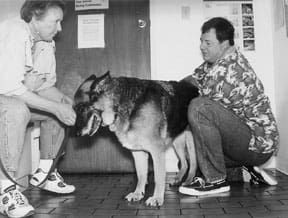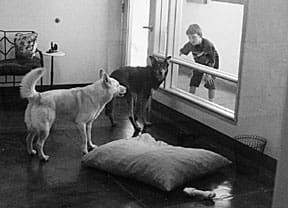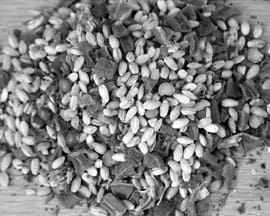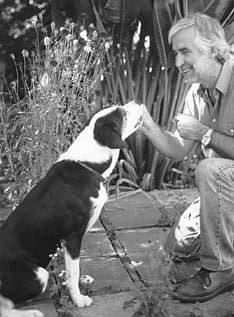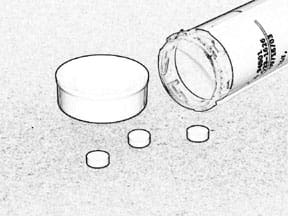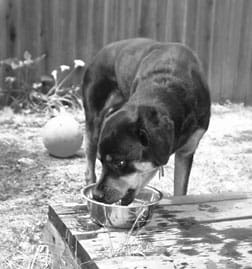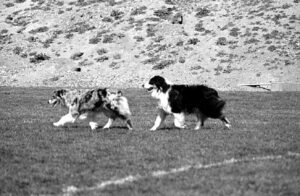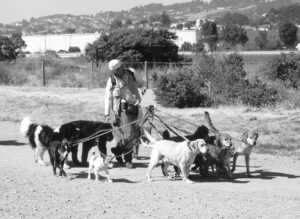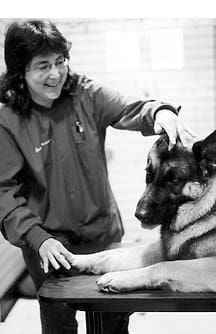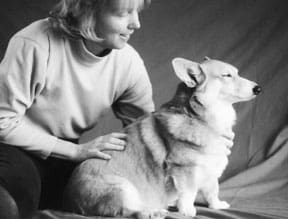Over the years I have treated literally thousands of animal patients for allergic problems, using both Western and alternative medicine methods. I have a multi-tome library of books devoted to the subject of allergies, and my allergy file-folders bulge with articles from dozens of professional journals, magazines, and Web sites.
Still, I am searching for answers.
The more I think I know about allergies, the more I read and learn about them, the more confused I get. Nothing I have tried therapeutically works with all my patients; some patients get better with hardly any effort on my part; others finally respond to my third or fourth treatment protocol (or 9th or 10th); and some never respond, no matter what I try.
Often, as I try to figure out how to give some semblance of relief for a dog’s itches, it feels like the three of us – the dog, the dog’s caretaker, and I – are stuck in the midst of a huge maze, blindly trying to find our way to the outside. And, while there may be some general rules that can help get us through the majority of the mazes (see sidebar), each and every allergic patient has its own unique construct, and the pathway through the maze is likely to be very different for every individual.
The following pathway in this article is meant to help you navigate most cases of allergy, most of the time.
How Allergy Manifests in Dogs
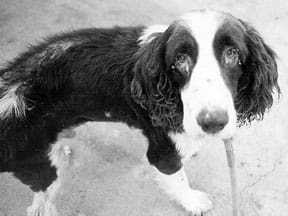
Allergies can present as a variety of symptoms, but in the dog, the most common symptoms occur as skin irritations: itching, scratching, digging, and gnawing at the skin, often to the point of creating open raw wounds over large areas of the body. Chronic ear infections are another common symptom. Occasionally dogs will have respiratory symptoms such as coughing, sneezing, or a nasal or ocular discharge. Food allergies may produce, in addition to skin irritations, vomiting and/or diarrhea. Symptoms can extend to include epileptiform seizures, and many holistic vets feel that allergies can ultimately result in chronic diseases such as arthritis, asthma, chronic urinary tract infections, inflammatory bowel disease, etc.
Interestingly, whereas dogs typically have itchy skin symptoms, a human allergic response usually produces respiratory symptoms. An estimated 10 percent of the human population may be allergic to animals (the rate for being allergic to cats is about twice as high as for dogs); a higher rate of 20 to 30 percent of individuals with asthma have pet allergies.
When Dogs’ Immune Systems Run Amok
It has been estimated that more than 70 percent of all skin conditions in dogs are allergy-related, but every allergic patient presents a unique diagnostic challenge, and merely deciding which diagnostic tests should be run can be the most challenging of all our decisions. The following suggestions will help you determine which of the myriad causes might be responsible for your dog’s allergies. From this information, you and your holistic veterinarian can determine the best therapeutic action(s) to take.
In a nutshell, allergy is the result of an immune system that has, for one reason or another, turned against the self. Sometimes, this reaction seems instantaneous, as when a dog receives a food that contains something to which he is allergic, and he breaks out almost immediately with rashy, itchy skin. But frequently, allergies may become made evident in your dog only after “gestating” for a long period, as long as four years or more. It can thus be almost impossible to pinpoint the exact cause that has instigated the symptoms.
We know there is a genetically derived propensity for developing allergies, but of course, there’s not much you can do about this after the fact, after your dog’s allergies have already begun to surface. About all we can do is to support breeders who select individuals for immune competence, Zheng Chi vigor, healthy vital force, or for any of the health-giving attributes necessary for long-term, holistic well-being.
First Steps to Relieving Pet Allergies
Make fleas flee. Most studies indicate that fleas are the number one cause of contact dermatitis in the canine species. So, it makes sense to look for fleas first, and if they are present, to use a low-toxic way to lower their numbers in the environment – in as natural a way as is possible. (See “Eliminate Fleas Without Poisons,” WDJ March 2002.)
However, if your dog is highly allergic to fleas, you may not have the luxury of taking your time to reduce flea populations. In these cases, a careful, limited use of the highly effective (and sometimes dangerous) “spot-on” pesticides may be necessary to quickly eliminate the flea population. This can give you time to improve his overall health and ability to withstand an occasional flea bite. Of course, a blind and sole reliance on pesticides is not recommended (see “Are Spot-On Flea Killers Safe?” February 2002).
Treat skin lesions. A holistic approach to allergies understands that external, skin symptoms are merely an outer manifestation of something going wrong inside. This is contrary to the conventional Western medicine way of thinking in which, often, only the symptoms are attacked, with little or no concern for the underlying cause.
That said, you must tend to the skin lesions, possibly with topical medications and/or soothing baths, as you work your way through the diagnostic and medical challenges of the allergic case. My favorite topical medicine for almost any skin lesion is to apply a spritz made from a tea brewed from calendula flowers (Calendula officinalis), several times a day, directly to the lesion. Other herbs such as chamomile (Matricaria chamomilla or Anthemus nobile), yarrow (Achillea millefolium), lavender (Lavendula officinalis), and mullein (Verbascum thapsus) may also be added to the herbal brew.
In every case of allergy, I initiate immediate treatment of the dog’s gastrointestinal system. As we heal the gut, we in turn enhance the immune system – recognizing that a good portion of the immune system is located in the gut wall. A balanced immune system helps the dog deal naturally with any allergen that may be causing allergic reactions, whether this allergen is contact (skin-induced), inhalant (respiratory induced), or gut induced (food allergy). It’s been my experience that if we can get the immune system balanced, most, if not all allergies, tend to go away.
Further, though I have not seen any studies that confirm this, experience has proven to me (and many other veterinarians) that some animals are allergic to the preservatives, artificial flavors, and/or artificial colorings found in some commercial dog foods. Oftentimes a simple upgrade to a higher quality diet without artificial ingredients eliminates the allergies.
I treat this “gut-check” step much as I would a confirmed case of Inflammatory Bowel Disease. Here’s where your holistic practitioner can help devise a protocol that is definitive for your dog. My general approach is to detoxify first, probably with a mild herbal laxative such as aloe (Aloe vera), or senna (Cassia spp.). Then I add herbal liver helpers such as dandelion root (Taraxacum officinale), and milk thistle seeds (Silybum marianum). I’ll also try to return the gut to a normal flora by adding beneficial bugs (Lactobacillus and other so-called probiotics) and increasing the dietary fiber.
As I am working with the gut, I will try to enhance a balanced immune system using herbs such as echinacea (Echinacea spp.) or Siberian ginseng (Eleutherococcus senticosus). Immune enhancing supplements including vitamins C and A and zinc may also be helpful.
Essential fatty acids (EFAs) are a group of chemicals found in some foods, and some of them can be converted into beneficial prostaglandins. At the top of the beneficial list are the Omega-3 EFAs found in flax oil and deep sea fish such as salmon, haddock, and cod, and gamma-linolenic acid (GLA), found in evening primrose, borage, and black currant seed oil. A combination of the Omega-3s and GLA seems to have the most potent effect.
A natural anti-inflammatory or cortisone-like herb such as licorice root (Glyceriza glabra) may enhance the adrenal gland and also take some of the itch away.
Many of the holistic vets I know have found that an addition of some raw meat to the diet often alleviates the symptoms. Interestingly, in what may seem to be a paradoxical finding, I’ve had several animals who tested as allergic to a specific meat eliminate their allergies when we’ve added that particular meat (raw) to the diet. Note that these have all been animals that were treated beforehand to enhance their gut immunity, with the above inflammatory bowel protocol.
Realize that in this protocol we are simply upgrading the diet and adding anti-inflammatory and immune-enhancing nutrients. This is not a “food elimination” test for food allergies – a test that we might consider down the road, if these first steps don’t seem to work. A true food elimination diet is more complex than this and will take at least two months of a strict dietary regime before we’ll have a diagnostic answer. (See sidebar.)
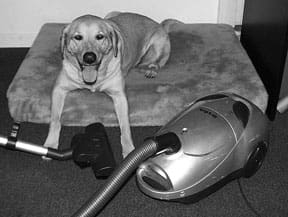
There is a certain amount of discipline involved with setting aside the obvious skin condition for a time while you change diets and add supplements, while you begin to think in terms of whole-body, long-term effects of whatever therapies you will use in the future. Not everyone has the time, patience, or forbearance to go through a holistic protocol for treating allergies, and it’s a waste of time for everyone concerned to try to force a holistic protocol on someone who only wants a quick fix.
The Value and Limits of Allergy Testing Dogs
If we don’t have much luck alleviating symptoms after we’ve eliminated the fleas and changed the diet, then we are confronted with further challenges.
A dog (or any animal) may become allergic to almost any substance that exists in the real world. Furthermore, there are many diseases – external parasites, fungal or bacterial infections, hormonal conditions (hypothyroidism in particular), to name just a few – that create very similar symptoms to those caused by allergies.
The challenge is to figure out which substance, bug, or agent is creating the allergic response – and we may not be able to determine that substance. Not ever. Or we may be lucky and find a diagnostic test that elucidates the one cause of the allergy, and all we have to do is either eliminate this one cause from the dog’s environment or create an inner environment whereby he can counter the cause.
Using the Western medicine approach, we might decide that a complete blood count and blood chemistry would narrow our list of possible causes. A thyroid panel might also be helpful, but remember that animals will often test low for thyroxin (T-4) whenever they are sick (as with allergies). So, a low T-4 may only indicate an animal suffering from allergies; not an animal that is hypothyroid.
Oftentimes these tests are more helpful for eliminating potential causes than they are for creating a specific diagnosis. And my usual caveat for testing definitely applies here: “Only do those diagnostic tests that, depending on their outcome, will change your treatment protocol. To do otherwise is a waste of time and money.”
There are two basic types of allergy testing for specific causes: skin and blood testing. The skin test injects small amounts of potential antigens into the skin, and the practitioner looks for an excess reaction around the injection site – indicating a possible allergy to the injected substance. Various blood tests, such as the RAST (radioallergosorbent) and ELISA (enzyme-linked immunosorbent assay) tests, check for antigen-induced antibodies in the dog’s blood. If we can identify a specific allergen from the testing, we can then desensitize the patient by injecting small doses of the allergen over a period of time – often extending over several years.
However, all of these tests have problems inherent in their design, and depending on their personal experiences with them, practitioners either “swear at” or “swear by” them. Part of the problem is that the tests are not very accurate; false positives and false negatives are common. Furthermore, and this may be an even worse problem, when we do determine what substance a dog is allergic to, we may conclude that we won’t be able to eliminate or reduce his exposure to the allergen anyway.
For example, say that tests indicate that your dog is allergic to house dust and the oak trees that grow naturally all around your neighborhood. To avoid all of this dog’s allergies, we’d have to sterilize the house and deforest the town – not practical solutions!
The Pathway of Allergy Treatments
Even the pathway we choose to take when we decide which medicine to use is not an easy or clear-cut choice. Whatever medical system we opt to use, we need to understand that each method has its way of looking at health and disease (its diagnostic and treatment paradigms) and its own set of advantages and disadvantages when treating allergies.
Conventional Western medicine’s paradigm is to confront the disease with biochemical methods (think war metaphors) and to palliate the symptoms so the patient looks well on the surface. Western medicine’s most common therapy for allergies is to use either one of the glucocorticoids or an antihistamine. Glucocorticoids have a litany of adverse side effects (see “Use Corticosteroids With Caution,” WDJ July 2004), especially when used for prolonged periods, and antihistamines can adversely affect a number of body systems in many patients. On the other hand, both these drug categories are fast-acting and are powerful at palliating the itchy skin symptoms.
There has been a recent spate of newer, non-steroidal drugs on the market. Most of these are simply another way to shut down the immune system’s overreaction. The problem is, of course, that no matter how we do it, when we shut down the immune system (rather than attempting to balance or enhance its ability as we do with alternative medicines), we have opened the door to infections and other complications of a nonfunctioning immune system.
Atopica (cyclosporine), a drug sold by Novartis, is an interesting example. Its package insert lists the following adverse reactions: vomiting (30.9 percent); diarrhea (20 percent); persistent otitis externa (6.8 percent); urinary tract infection (3.8 percent); gingival hyperplasia (2.3 percent); and lymphadenopathy (2.3 percent). Contra-indications include “dogs with a history of malignant neoplasia” (hmm), and according to the insert: “killed vaccines are recommended for dogs receiving Atopica because the impact of cyclosporine on the immune response to modified live vaccines is unknown . . .” (double hmmm).
Way back in the 1980s, cyclosporine was used as immunosuppressive therapy to eliminate organ rejection during organ transplantation. Its mechanism of action seems to be to suppress the activation of CD4 Helper T (lymphocyte) cells – that is, it has a mechanism of action different from the glucocorticoids, but with basically the same result: immunosuppression.
Then there are the alternative and complementary pathways.
Homeopathy works with the patient’s inner vital force, to enhance the ability to dispel any disease, including allergies. Homeopathic medicine is typically slow to work, and (at least in my experience when treating allergies) it is critical to find the specifically appropriate remedy that matches the totality of symptoms (“classical homeopathy”) – a process that can take many months.
Homeopathic remedies may cause aggravations, and unfortunately the aggravations often take on the appearance of a recurrence of the skin symptoms. It can be difficult to differentiate between a homeopathic aggravation (a good sign) and a worsening of the condition. Homeopathic cures are typically whole-body and long-lasting, although many of my patients have needed to re-dose their remedy every few months or so.
Acupuncture works by balancing the patient’s chi. In the case of allergies, the chi is overly active and needs to be calmed. “Zheng chi,” as the corollary to the immune system, is also enhanced.
In my experience, acupuncture almost always takes at least four or five treatments before we can determine its effectiveness, and the total number of treatments may reach a dozen or more. Most of my allergy patients need to return for follow-up acupuncture treatments on a periodic basis, usually a few times a year.
Although there are times when a simple herbal remedy is exactly what an allergic patient needs, I often find herbal remedies to be very mild in action and slow to work. I find them most helpful in enhancing and balancing specific organ systems that are under duress from the allergic condition.
I’ve seen many cases of localized skin lesions that have responded favorably and rapidly to chiropractic. Presumably, when a vertebra is out of alignment, the irritation to the associated nerve endings sends a sensation to the skin area that the dog interprets as, “Dang, that itches!” And so he scratches and bites until the chiropractic treatment readjusts the vertebral alignment.
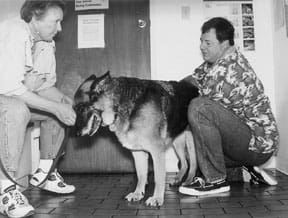
There are a number of other therapies that occasionally surprise me with their effectiveness, especially flower essences, which work to balance the emotions, and aromatherapy, which works at a subtle inner-brain level. There are several methods that utilize various forms of applied kinesiology as an aid to both diagnosis and treatment. (Applied kinesiology tests the body’s reaction to a substance to determine if the subject is allergic to it, and it can also be used to “test” for the expected effectiveness of treatment preparations.)
Perhaps the most important concept to be clear with here is that Western medicine’s way of diagnosis (and its philosophy of treatment) is very different from alternative medicine’s methods. When a Western-trained practitioner sees an allergic animal, he immediately visualizes the biochemical symbols that are running amok, and his plan of attack is to use chemicals to block the out-of-control biochemical reactions.
An acupuncturist, on the other hand, might see an allergic response as an imbalance of energy or chi, specifically “Zheng chi” or “Righteous chi,” the Traditional Chinese Medicine correlate to the immune system.
Part of the acupuncturist’s thera-peutic approach, then, will be to enhance the Zheng chi, the life force that maintains homeodynamic bal-ance and produces optimal health.
Canine Allergy Treatment Summary
My general treatment protocol for allergies, then, would look something like this:
• Reduce the flea populations on and around the dog.
• Reduce the potential for food allergies by improving the quality of the food, and at the same time . . .
• Enhance the immune system with high-quality food and nutritional supplements.
• Don’t challenge the immune system excessively – with any vaccines that are less than absolutely necessary, for example.
• Use natural anti-inflammatory herbs and supplements.
• Consider acupuncture or homeopathy for chronic and/or severe cases (NOTE: I’ve often been disappointed when using these two in combination for treating allergies).
• Reduce environmental causes of allergy – airborne smoke and dust particles, for example. Air quality is important in preventing the passage of allergens through the air. If your dog (or anyone else in the family) has allergies, consider using a quality household air filter.
• Whenever possible, use methods that enhance the animal’s innate ability to balance its own immune system and use methods that are the most natural and have the least potential for toxicity. However . . .
• If early therapeutic attempts are not productive, consider testing for specific allergens (using skin or blood tests or a food elimination diet) if other methods do not seem to be working.
• There may come a time when you may need to resort to medicines we know to be toxic and/or medicines that shut down the immune system rather than helping to balance it. Only you can decide when your dog and even you cannot take any more itching and scratching, and the loss of hair, skin, weight, sleep, and/or sanity that often accompanies severe allergy.
It has been said that sometimes, along our journey to wellness, we need to see and feel how it looks and feels to be well, so we can try to get back to this place. Sometimes I get the feeling that dogs affected with allergies – after perhaps months of itching and scratching, of evident pain and sleep loss – have forgotten how it feels to be well. With these cases, I think it is important to let them experience wellness, however briefly, even if it means that we may have to resort to types of medications such as glucocorticoids and/or antihistamines that I would ultimately like to avoid.
I think we need to approach allergies (and other chronic diseases) with an under-standing that the treatment protocol we choose will likely require time, effort, and discipline; that we may never be able to come up with a treatment regime using a linear-logical approach; and that, in the end, we may not truly find our way out of the maze of allergies, no matter what we try.
Dr. Randy Kidd earned his DVM degree from Ohio State University and his Ph.D. in Pathology/Clinical Pathology from Kansas State University. A past president of the American Holistic Veterinary Medical Association, he’s author of Dr. Kidd’s Guide to Herbal Dog Care, and Dr. Kidd’s Guide to Herbal Cat Care.


